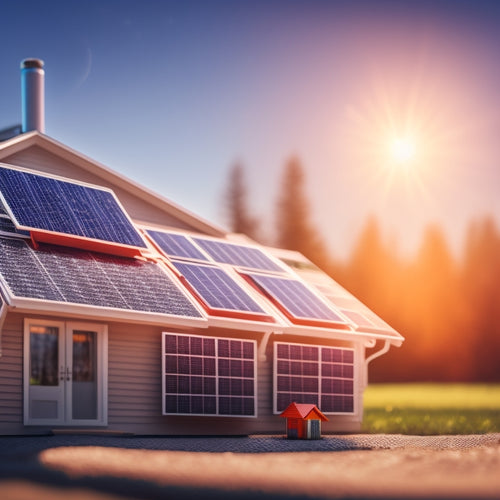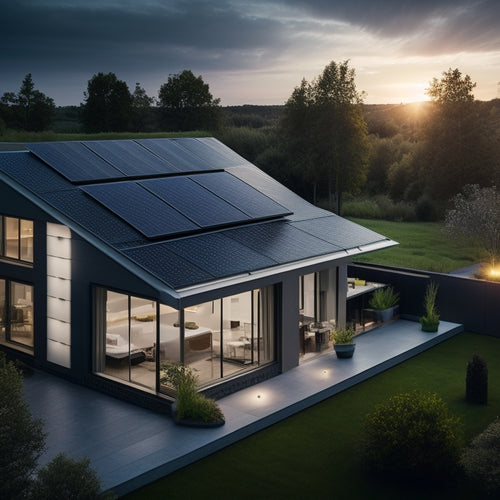
What You Need for a DIY Energy System
Share
To craft a self-sustaining DIY energy system, you'll need to assess your energy needs by tracking appliance usage, wattage, and operational hours to calculate total energy consumption in watt-hours per day. Next, choose the right components, including solar panels, inverters, batteries, charge controllers, and mounting systems, considering factors like efficiency, cost, durability, and compatibility. You'll also need to size your solar array and select a suitable battery bank based on your energy demands and available space. Finally, you'll require mounting and connecting hardware, adhering to electrical safety guidelines and industry standards for a safe and efficient system - and that's just the starting point.
Overview
- Assess energy needs by tracking daily appliance usage, wattage, and operational hours to determine total energy consumption in watt-hours per day.
- Choose the right components, including solar panels, inverters, batteries, and charge controllers, considering efficiency, cost, durability, and compatibility.
- Size the solar array correctly based on daily energy requirements, available space, and local solar irradiance to ensure adequate energy supply.
- Select a suitable battery bank type and size based on energy demands, maintenance needs, and desired energy offset from solar power.
- Ensure safe and efficient transmission of power from the solar array to the battery bank using appropriate mounting and connecting hardware.
Assessing Your Energy Needs
About 30% of your monthly expenses likely go towards energy consumption, making it crucial to determine your energy needs accurately. You can't build a DIY energy system without knowing how much energy you need to generate.
To assess your energy needs, start by tracking your lifestyle habits. Identify the appliances and devices you use daily, their wattage, and the number of hours you use them. Calculate your total energy consumption in watt-hours (Wh) per day.
Consider device efficiency and potential system losses in your calculations, as they can greatly impact your overall energy requirements. Accurate load calculation guarantees a reliable power supply and customized system design.
Consider your energy usage patterns, such as peak hours and seasonal variations. This data will help you determine the size of the energy system you need to build, assuring you have the freedom to power your life independently.
Choosing the Right Components
You've calculated your energy needs, now it's time to select the right components for your DIY energy system. Choosing the right components is vital to guarantee your system functions efficiently and meets your energy requirements.
| Component | Options | Considerations |
|---|---|---|
| Solar Panel | Monocrystalline, Polycrystalline, Thin-Film | Efficiency, cost, and durability |
| Inverter | String Inverter, Microinverter, Power Optimizer | Compatibility, efficiency, and monitoring capabilities |
| Battery | Lead-Acid, Lithium-Ion, Saltwater | Depth of discharge, cycle life, and maintenance |
| Charge Controller | PWM, MPPT | Efficiency, voltage regulation, and compatibility |
| Mounting System | Roof Mount, Ground Mount, Tracking System | Durability, adjustability, and installation ease |
When selecting components, consider factors such as efficiency, cost, durability, and compatibility. Research and compare different options to find the best fit for your DIY energy system.
Sizing Your Solar Array
Three key factors determine the size of your solar array: your energy needs, the amount of available space, and the local solar irradiance.
You'll need to calculate how much energy you require daily, taking into consideration your appliance wattages and usage hours.
Next, assess the space available for your solar panels, factoring in obstacles like trees or buildings that might cast shade.
It's crucial to conduct an energy audit to understand your historical consumption and future energy changes.
Additionally, consider the desired energy offset from solar power to guarantee you're meeting your energy needs.
Finally, research the local solar irradiance, which affects the amount of energy your panels can generate.
With these factors in mind, you can choose the right solar panel efficiency and array orientation to maximize energy production.
A well-designed array will guarantee you generate enough power to meet your needs, giving you the freedom to live off the grid.
Selecting a Battery Bank
Now that you've determined the size of your solar array, it's time to focus on selecting a battery bank that can efficiently store the generated energy.
You'll need to decide on the type of battery that suits your needs, taking into account factors such as depth of discharge, cycle life, and maintenance requirements. Lead-acid batteries are a cost-effective option, while lithium-ion batteries offer higher efficiency and longer lifetimes.
When choosing a battery, it's crucial to evaluate the maintenance frequency of your chosen battery, as well as the importance of battery management systems for peak performance.
When it comes to capacity considerations, you'll need to calculate the total ampere-hours required to meet your energy demands during periods of low sunlight or extended power outages.
Be sure to oversize your battery bank to account for unexpected energy shortfalls and guarantee a reliable DIY energy system.
Mounting and Connecting Hardware
The mounting and connecting hardware is a critical component of your DIY energy system, as it guarantees the safe and efficient transmission of power from your solar array to your battery bank and ultimately to your appliances.
You'll need to choose from various mounting options to secure your solar panels, such as roof-mounted, ground-mounted, or tracking systems.
When it comes to connection types, you'll need to select the right cables, connectors, and fuses to guarantee a reliable and efficient energy flow.
Consider using MC4 connectors for your solar panels and 2/0 AWG cables for high-current connections.
Make certain to follow proper electrical safety guidelines and industry standards to guarantee a safe and functional DIY energy system.
Frequently Asked Questions
Can I Install a DIY Energy System in a Rented Property?
You'll need to obtain renter permissions before installing a DIY energy system, and be prepared to overcome installation challenges like securing necessary permits and working around existing electrical infrastructure.
Are DIY Energy Systems Compatible With All Types of Roofing Materials?
You're probably imagining a utopian rooftop utopia, but let's get real - DIY energy systems aren't compatible with all roofing materials. You'll need to take into account installation constraints, like weight and structural integrity, to guarantee a seamless integration with roofing types, from asphalt shingles to corrugated metal.
Do I Need to Notify My Utility Company About My DIY System?
You'll need to notify your utility company about your DIY system, as they have regulations to follow; obtaining necessary permits guarantees compliance, and it's essential to understand their requirements to avoid potential fines or disconnection.
Can I Expand My DIY Energy System in the Future if Needed?
You'll want to design your DIY energy system with future upgrades in mind, ensuring system scalability to accommodate growing energy needs, so you can easily add components as needed, without having to overhaul the entire system.
Are DIY Energy Systems Safe From Electrical Shock and Fire Hazards?
When building a DIY energy system, you guarantee safety by taking shock prevention measures, like grounding components and using insulated wiring, and implementing safety precautions, such as surge protectors and circuit breakers, to minimize electrical shock and fire hazards.
Ready to Buy
You've finally got all the pieces in place for your DIY energy system. Now it's time to "get down to brass tacks" and start building. Remember, a well-planned system is key to utilizing renewable energy efficiently. With your solar array, battery bank, and mounting hardware in check, you're ready to power up and start saving on those energy bills. Stay organized, follow safety guidelines, and don't hesitate to seek help when needed. You're just a few connections away from energy independence!
Related Posts
-

A Beginner's Guide to Navigating the Solar Investment Tax Credit
You're eligible to claim a significant Solar Investment Tax Credit (ITC) of 30% of total installation costs, but mane...
-
Average Lifespan of Solar Battery Banks
The average lifespan of solar battery banks generally ranges from 5 to 15 years. This variation mainly stems from the...
-

Home Solar Battery
You're opting for a home solar battery that allows you to utilize the power of the sun during the day and use it at n...

